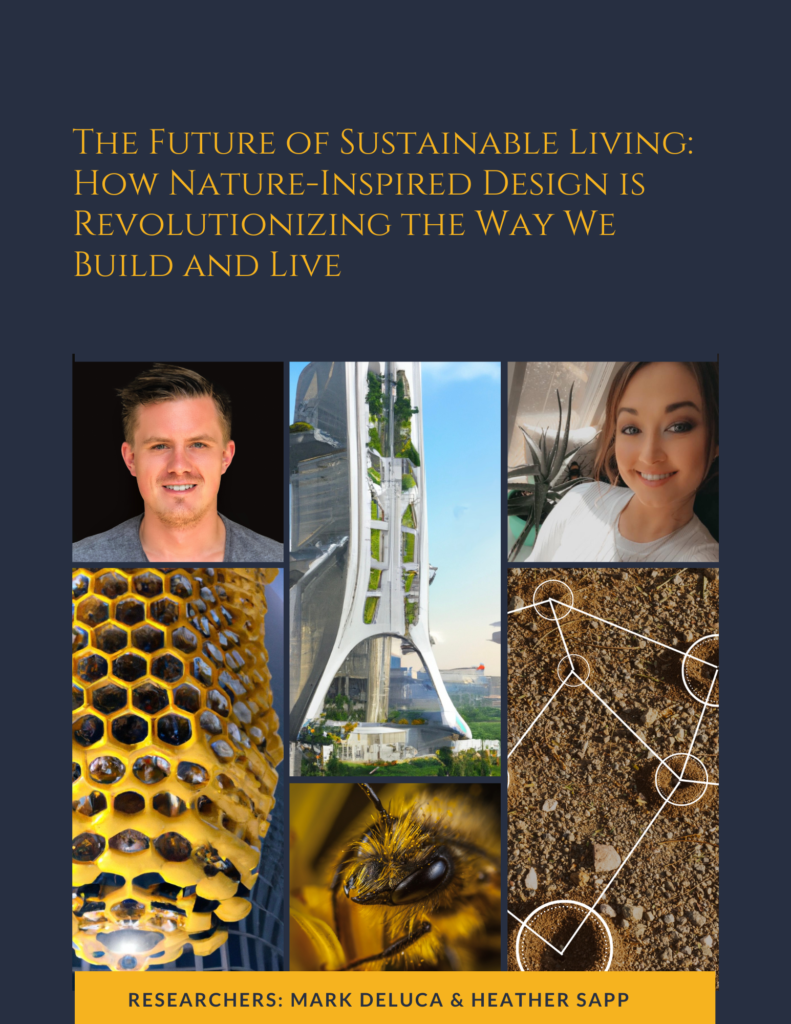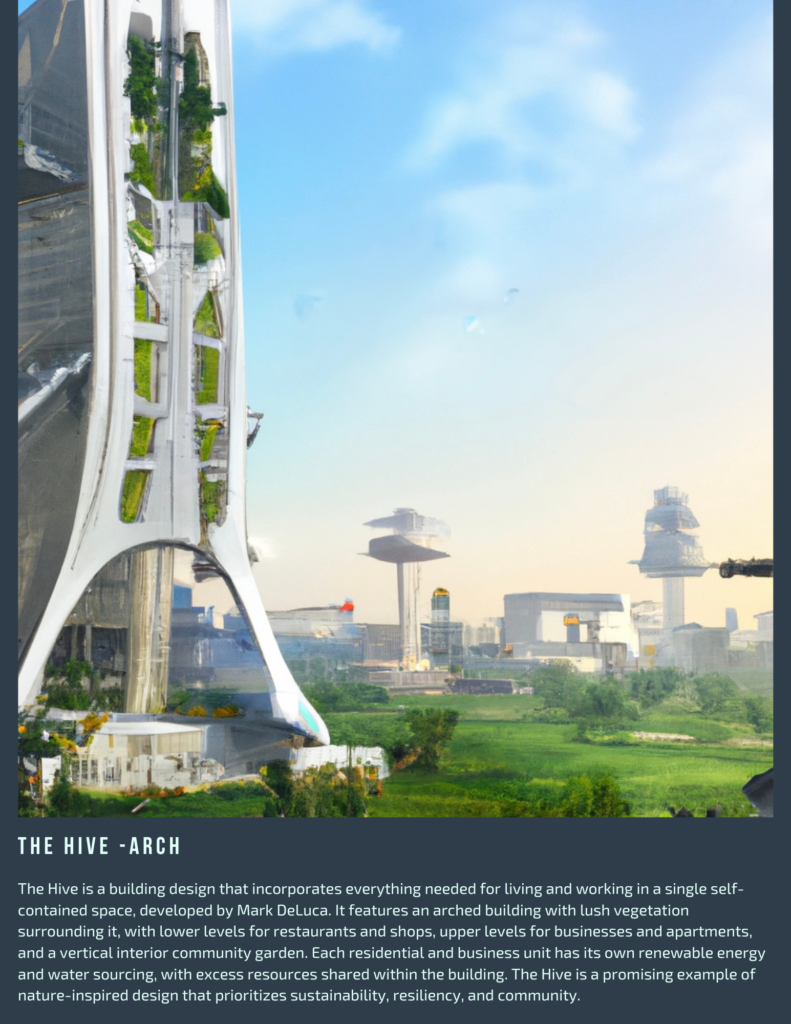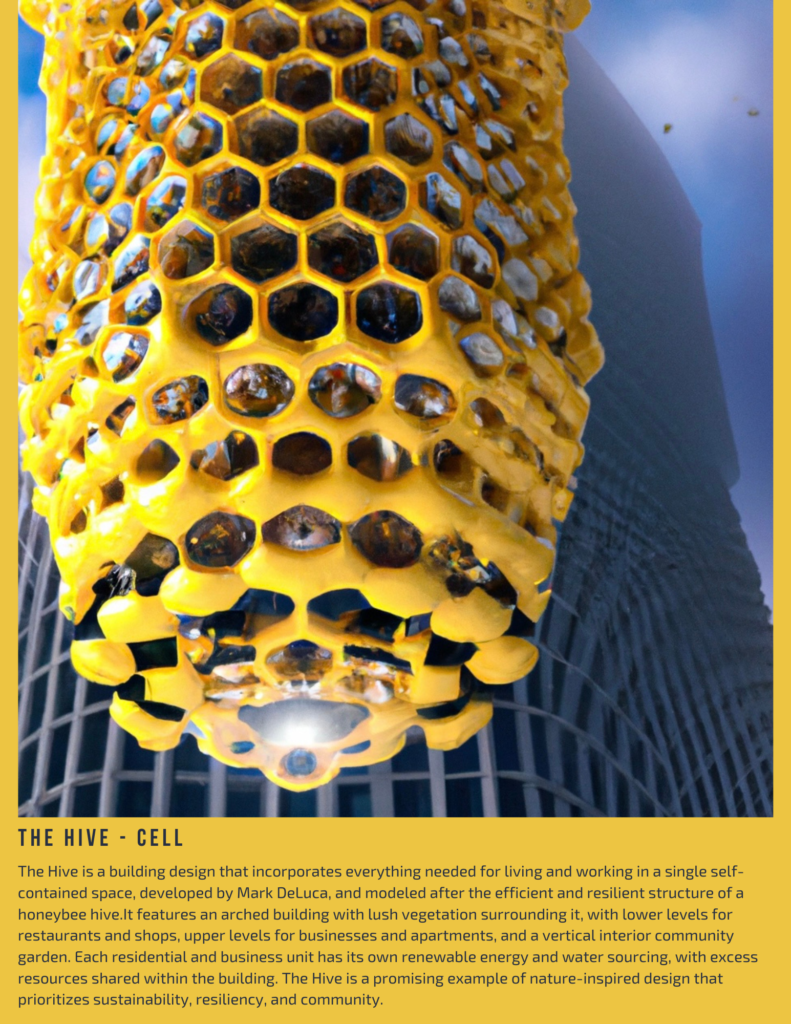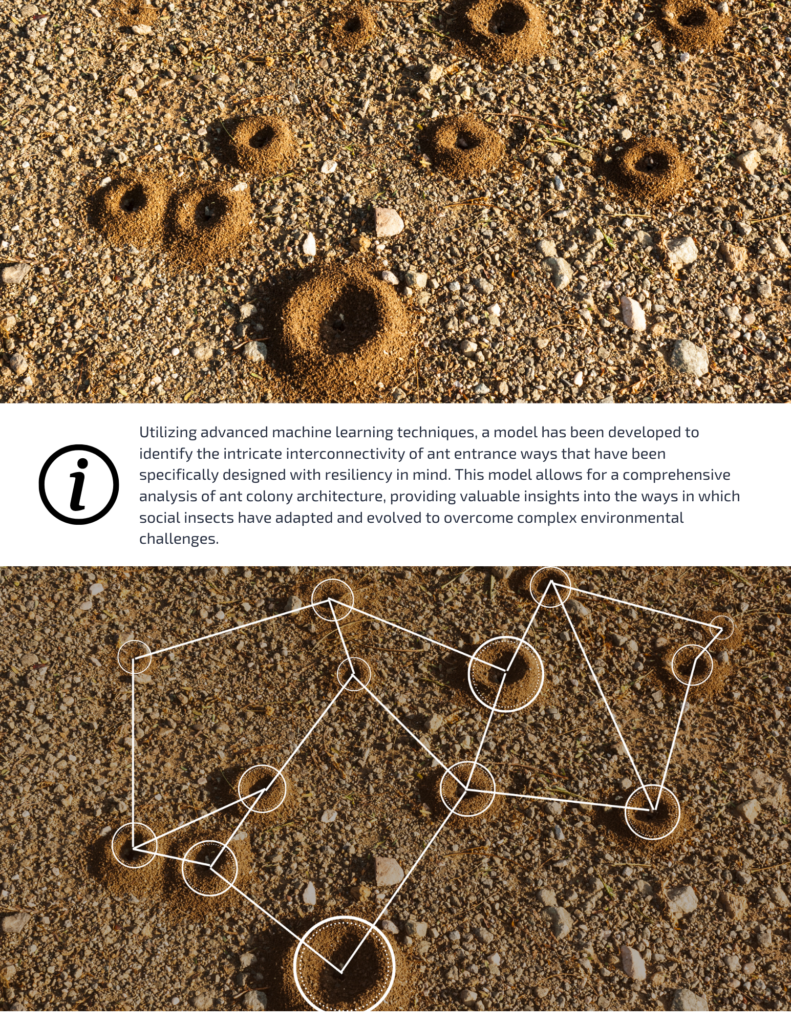
Sustainability
The Future of Sustainable Living
The Research Report is readily available for your view through LinkedIn or via the below text. We recommend that you view and subscribe to the Journey To Earth Newsletter on LinkedIn for regular updates on our latest research and news.
How Nature-Inspired Design is Revolutionizing the Way We Build and Live
Assigned Researchers & Explorers: Mark DeLuca & Heather Sapp
Journey To Earth
Authors Note
I feel it is essential to underscore the value of exploring and expanding our knowledge in order to drive innovation and progress. By being open to new ideas and approaches, and by actively seeking out opportunities to learn and grow, we can discover new insights and perspectives that may help us overcome even the most complex challenges. It is only through a willingness to push beyond our boundaries and engage with diverse perspectives that we can truly foster innovation and make meaningful progress towards a brighter future.
Abstract
Planet earth is a formidable 4.54 billion-year-old astronomical body that is host to an array of life forms. Amongst these life forms are humans, who have called earth their home for a mere 200,000 years, compared to the estimated 170 million years that social and intelligent insects have lived here. It’s remarkable to note that both humans and insects rely on complex infrastructure systems for their survival and well-being. Can we, as humans, learn from these intelligent insects to build better, more sustainable, and resilient critical infrastructure, lifestyles, and architecture? The question takes on a sense of urgency when we consider the consequences of being unprepared. A glaring example of this are the events that unfolded in Texas in February 2021, where a severe winter weather system brought freezing temperatures, resulting in 246 deaths and a staggering $195 billion in losses. The deep freeze exposed the vulnerabilities of our critical infrastructure, which was not designed with resiliency and sustainability in mind. In this research, we will delve into the lessons that can be learned from social intelligence in insects, the case study of the Texas deep freeze, and present an innovative solution that could potentially save us from a similar catastrophe in the future. With the advent of new and innovative technology, it’s time to integrate these advancements into our critical infrastructure and bring about a much-needed change. This research study represents a proof-of-concept, intended to identify whether further research into a given area is likely to yield significant results. By conducting an initial investigation into the feasibility and potential value of a particular research question, we can determine whether it is worthwhile to invest additional time, effort, and resources into exploring the topic in greater depth. Through this process, we are better equipped to make informed decisions about the direction and scope of future research efforts. Let’s work together to build a better, more sustainable future.
As a society, we must strive for resiliency in our critical infrastructure to ensure its ability to function, even in the face of disruptive events. This requires a carefully crafted balance between tolerance and design, with the goal of returning the system to a state of equal or improved performance following a disruption. Investing in resiliency not only reduces the likelihood of degradation or issues during a disruption, but also demonstrates a commitment to a sustainable and secure future. As I embark on my research journey, I find myself surrounded by a unique and awe-inspiring individual, Heather Sapp, an accomplished apiarist who is a true master of her craft. Her contagious passion and high level of purpose drives her work, inspiring those around her to share in her excitement. As I stand surrounded by thousands of buzzing honeybees, I am struck by the incredible organization and efficiency of their decentralized system. In this system, decisions are based on local information and made in real-time, without the need for a central authority. This approach eliminates the possibility of bias and ensures objective decision-making. Observing this process, I am reminded of the valuable lessons that can be learned from nature, and the impact they can have on the future of our critical infrastructure.
Honeybee hive cells are a fascinating example of efficient and resilient design. The cells within a honeybee hive are built using a combination of wax and honey, which the bees produce and manipulate to create hexagonal-shaped compartments. The cells serve as the foundation of the hive, providing a place for the bees to store honey, rear their young, and carry out various other tasks. One of the key lessons that we can learn from honeybee hives in terms of resiliency and sustainability is the use of efficient geometry. The hexagonal shape of the cells allows the bees to make the most of their available space, maximizing storage capacity and minimizing waste. This efficient design also ensures that the cells are strong and stable, resisting collapse even under heavy loads. Another important aspect of honeybee hives is the interlocking structure of the cells. Each cell is reinforced by its neighbors, creating a stable and robust framework for the hive. This interlocking design not only provides structural stability, but also helps to regulate temperature and humidity within the hive, ensuring a stable environment for the bees to thrive.
Heather explains a common process known as swarming. A honeybee swarm is a phenomenon in which a large group of honeybees leaves their original colony and moves to a new location to establish a new hive. This typically occurs when the original colony becomes overcrowded, and the bees begin to swarm to find a new home. During a swarm, the bees will cluster together in a large ball, often hanging from a tree branch or other object, while scout bees search for a suitable new location to build their hive. Honeybee swarming is an important process in the life cycle of a honeybee colony. It allows the colony to reproduce and spread, helping to ensure its survival over time. This is because a swarm of bees represents a significant portion of the original colony’s population, giving the new colony a strong foundation for growth and development. From a human perspective, honeybee swarming also provides important lessons about the importance of adaptation and resilience. By leaving their original colony and establishing a new one, the bees are demonstrating their ability to adapt to changing conditions and overcome challenges. This is a valuable lesson for humans, who can learn from the bees’ example and apply it to their own lives, seeking out new opportunities and finding ways to overcome obstacles and succeed. In addition, honeybee swarming can also serve as a reminder of the importance of maintaining a healthy and sustainable environment. By understanding the reasons behind honeybee swarming and the conditions that trigger it, we can work to protect and preserve the natural habitats that support these important insects. This, in turn, can help to ensure a stable and resilient food supply, as honeybees play a critical role in pollinating many of the crops that sustain us.
Honeybee swarming can also teach us valuable lessons about the importance of proactive planning, efficient resource allocation, and adaptive management of critical infrastructure. One of the key lessons from honeybee swarming is the importance of proactive planning and preparation. By anticipating the need for a new colony, the bees can ensure their survival and the continued success of their species. This can serve as a reminder for humans to proactively plan and prepare for potential challenges and changes that may impact our critical infrastructure. Another important lesson from honeybee swarming is the importance of efficient resource allocation. During a swarm, the bees can effectively allocate their resources, such as food stores, to ensure the success of the new colony. This can serve as an example for humans to optimize the use of resources in our critical infrastructure, such as energy, water, and materials, to ensure the sustainability and resiliency of our systems. Finally, honeybee swarming also highlights the importance of adaptive management. By adapting to changing conditions and finding new solutions, the bees can overcome challenges and establish a new and successful colony. This can serve as a model for humans to adopt an adaptive approach to the management of our critical infrastructure, seeking out new and innovative solutions to address challenges and ensure resiliency over time. Another remarkable aspect of honeybee hives is their mastery of warehousing. Despite a lack of central leadership, honeybees can increase their workforce and resources when necessary. This ability to scale up is made possible by two key factors. Firstly, the presence of a significant amount of incoming nectar, and secondly, the collective awareness of the honeybees that a certain number of honeycomb cells have been filled. By adhering to this approach, the hive ensures that resources are not wasted, thereby enhancing their overall sustainability. This remarkable ability of honeybees to effectively manage their resources serves as a valuable lesson for us humans, as we strive to build more resilient and sustainable critical infrastructure systems.
Next, my research takes me deep into the forest, where I am studying the fascinating world of ant colonies. I am focusing on the methods used by ants to build their colonies and the strategies they use to enhance their resilience and efficiency. Using advanced technology, including cameras and machine learning, I have been able to gain insight into the intricacies of ant behavior. One of the most remarkable findings of my research is the way that ants build their colony entrances in a way that interconnects with each other. This approach serves to minimize the risk of single points of failure, as each colony entrance can function as a backup to the others. This approach to building is like the concept of Minimum Spanning Trees, which are used in computer science and engineering to create efficient and resilient network structures. In this case, the ants are essentially creating a Steiner Minimum Tree, which is a more advanced version of a Minimum Spanning Tree that can connect points that are not directly adjacent. By interconnecting their colony entrances in this way, the ants can create a highly resilient and efficient system that can withstand disruptions and continue to function even in the face of adversity. The insights gained from studying ant colonies and their use of interconnected entrances can be applied to our own efforts to build more resilient and efficient critical infrastructure. By adopting a similar approach to design, we can minimize the risk of single points of failure and create systems that are better able to withstand the challenges of a rapidly changing world.
In February of 2021, I led a disaster declaration following what has since become known as the “Great Texas Freeze.” This catastrophic event provides us with a valuable opportunity to study the lessons learned from this disaster, and how we can better prepare and respond to future events of a similar nature. The winter storms that triggered this disaster led to the worst energy infrastructure failure in Texas state history, resulting in shortages of essential resources such as water, food, and heat. More than 4.5 million homes and businesses were left without power, some for several days. The power grid, operated by ERCOT, was severely impacted, despite weather alerts being sent out five days in advance.
The day before the storm, energy loads reached their highest levels ever recorded. In response, emergency protocols were implemented, including reliance on backup capacity, bringing in power from neighboring regions, and as a last resort, rolling blackouts. Unfortunately, the rolling blackouts were quickly initiated, as the emergency protocols were insufficient to meet the needs of the impacted population. Post-disaster analysis identified several causes of the outages, including wind and natural gas sourcing, equipment failure, and fuel limitations. Critical locations, such as hospitals, were also severely impacted due to upstream dependency failures. It was revealed that resiliency and continuity testing had been conducted, but only for a range of three to four hours and during the summer season, leaving Texas unprepared for the prolonged impact of the winter storm. The disaster analysis that followed the Great Texas Freeze presents a valuable opportunity to identify the shortcomings in our current critical infrastructure and emergency protocols, and to make the necessary changes to ensure greater resilience and preparedness for future events. Through a comprehensive analysis of the Texas freeze, we can gain important insights into the interdependencies of our critical infrastructure, and how we can better prepare and respond to natural disasters in the future.
Now that we have completed our comprehensive research and analysis of social intelligent insects and the Dallas Deep Freeze disaster, it is time to apply the lessons learned to develop an innovative solution that will make a positive impact. Introducing “Home Sourcing,” a design that centers around gathering and utilizing resources at the residential and commercial levels. This approach is made possible through the integration of innovative solutions, such as wind turbines, solar panels, and renewable water systems. Under the Home Sourcing model, homes and businesses would primarily rely on the energy generated by their own wind turbines and solar panels. Any excess resources would be stored in a local storage bank and then shared with the community when needed. In the event of a disruption to the primary resource sourcing methods, the secondary sourcing option would be utility companies, which would bill customers for the resources used. By adopting the Home Sourcing approach, utility companies would be incentivized to focus on sourcing resources from clean and renewable options by obtaining excess resources from primary procurement options. A constant feedback loop to the power grid would also be established, allowing any extra resources not required to be stored at the residential or community level to be diverted to the power grid for use by the utility companies. The Home Sourcing model represents a promising solution for building more resilient and sustainable critical infrastructure systems. By prioritizing local resource generation and community sharing, we can reduce our dependence on centralized power grids, minimize the risk of single points of failure, and ensure a more sustainable future for generations to come.
The wealth of knowledge and insights that we have gained from our research and analysis can be directly applied to the development of innovative architecture. One such example is a design that I have developed, called “The Hive,” which incorporates all the necessary living elements within one self-contained space. To take this approach one step further, we can model each living space after a honeybee hive, incorporating elements of nature and decentralization to enhance resilience and sustainability. The building design features an arched structure that promotes a healthy, green environment surrounding the building. The lower levels of the structure include restaurants and shops, while the upper levels are dedicated to businesses, organizations, grocery stores, apartments, and entertainment venues. For those who need to work in an office, The Hive provides easy arrangements, although work from home is still encouraged. The vertical interior distance of the structure features a healthy community garden that is fed by rainwater collected from the top of the building. The roof also features a large community garden and social hangout space. Each residential and business unit within The Hive procures its own primary source of energy through solar panels and wind turbines. Water is also sourced from rain and retained for use. The structure itself gathers resources, first for its own use, and then diverts any excess to the residential and business units as needed. The top of the building features drone landing areas that provide seamless transportation, a modality that is likely to become increasingly common in the future. The Hive building design is an example of how we can incorporate the principles of sustainability, resiliency, and nature-inspired design to develop innovative and effective architecture. Through the incorporation of renewable energy sources, water conservation, and communal green spaces, we can build structures that promote a healthy and sustainable way of life for both individuals and communities.
In conclusion, the study of honeybee and ant colonies provides a fascinating insight into the workings of social insects and the value of decentralized systems. We can apply the principles of decentralized decision-making, redundancy, and scalability to improve our own critical infrastructure and disaster response systems. The lessons learned from the great Texas freeze have underscored the need for better preparedness and resiliency in our power grids, emergency protocols, and community support networks. In response, we can develop innovative solutions, such as Home Sourcing and The Hive, that prioritize local resource generation and community sharing, reduce our dependence on centralized power grids, minimize the risk of single points of failure, and ensure a more sustainable and resilient future. As we continue to face unprecedented environmental and social challenges, the study of social insects and decentralized systems provides a promising avenue for developing creative and effective solutions to complex problems.



